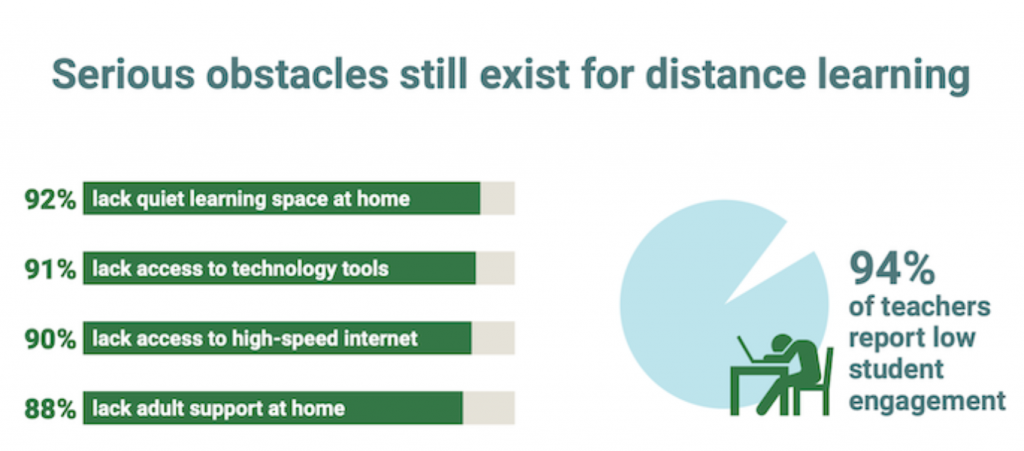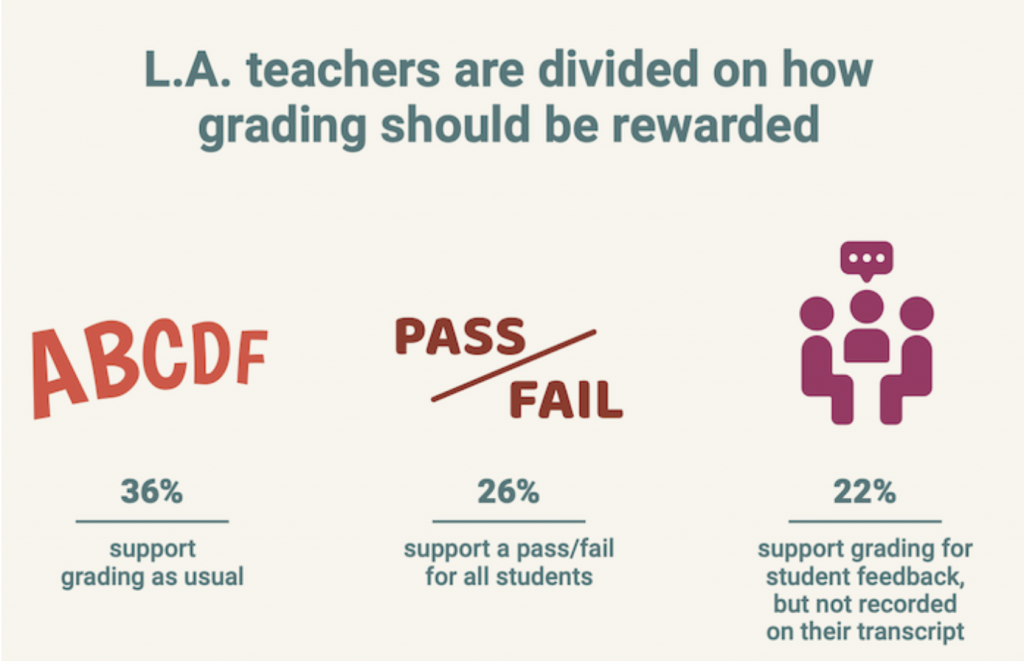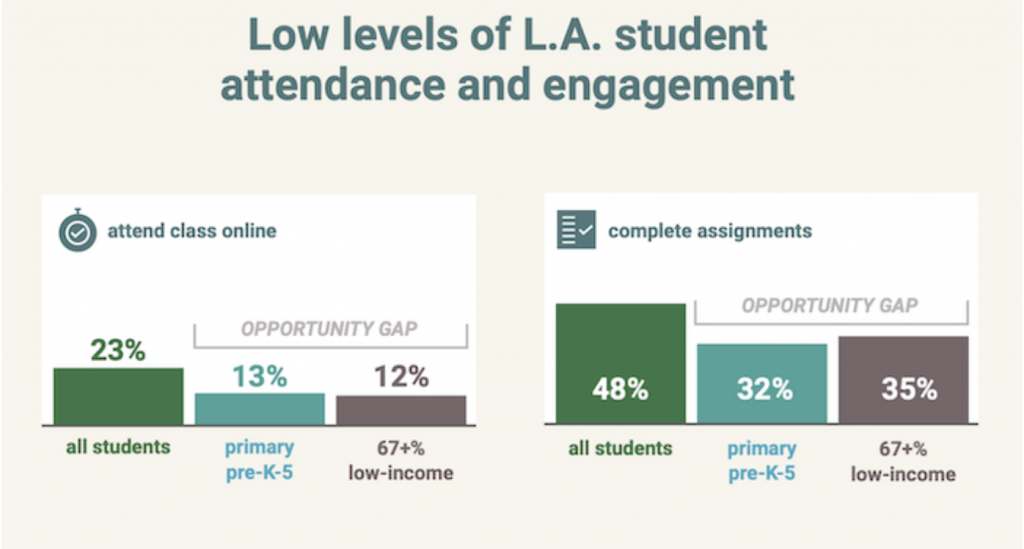Los Angeles— Educators for Excellence-Los Angeles, a teacher-led organization, and USC Rossier School of Education, released results today fromVoices from the (Virtual) Classroom: A Survey of Los Angeles Educators. The broadly representative survey of Los Angeles teachers, from district, magnet, pilot and charter public schools, explores the issues affecting students and the profession as the COVID-19 pandemic continues to impact education.
“My colleagues and I have done our best to serve our students during this pandemic, but our students are experiencing the largest disruption to education in generations,” said Meghann Seril, National Board Certified third-grade teacher and member of E4E-Los Angeles. “Although we have continued to adjust and adapt to distance learning during the past 10 months, we still lack the resources and quality guidance to ensure our students, especially the most vulnerable, are not shortchanged of the education they deserve.”
“It is disturbing that our educators and students are still facing some of the same fundamental challenges they did in the spring: low levels of engagement, lack of access to the internet, and lack of useful guidance to teach in this new learning environment,” said Patricia Burch, Professor at USC Rossier School of Education. “This cuts across the typical lines of difference—district versus charter, low-income versus high-income, race—but it is clear from educator voices that our vulnerable students are being the most impacted and need additional resources, time and support now.”
“We are witnessing the widening of the opportunity gap at such an extreme rate that the negative impact in our communities, economy and democracy will be felt long-term,” said Jeimee Estrada-Miller, Executive Director of E4E-Los Angeles. “For all our students the pandemic has caused havoc, but for children from low-income households the inequities are threatening their futures.”
“We need Los Angeles leaders to listen to teachers, parents and students, and take urgent action,” said Casey Jagusch, seventh-grade history teacher at Olive Vista Middle School and member of E4E-Los Angeles. “This survey shows that we want to return to the classroom when it is safe, but we can’t return to the status quo. Now is the perfect opportunity to reimagine education.”
“Los Angeles teachers are working incredibly hard amid terrible circumstances to provide the best quality education they can during the pandemic,” said Morgan Polikoff, Associate Professor at USC Rossier School of Education. “This survey provides concrete evidence about what teachers need in the short- and long-term to reshape our educational systems to better serve all students.”
In 2018, Educators for Excellence began publishing a national teacher survey, Voices from the Classroom. The 2020 edition was released in January this year, followed by a supplemental survey, Voices from the (Virtual) Classroom, in May. Voices from the (Virtual) Classroom: Los Angeles builds on these findings and provides critical insights into how the education landscape in Los Angeles has transformed during the pandemic. The 2021 national teacher survey is in progress and will be published in February.
Below are key findings from the survey. Visit e4e.org/virtualvoicesLA for the full report and detailed results, including a closer look at the following teacher subgroups: school type, grades teaching, years teaching and percentage of students from low-income households served.
KEY FINDINGS
- Ten months into distance learning, low levels of student attendance and engagement are alarming and a lack of access is still creating barriers, with our youngest and more vulnerable populations most impacted.
- Schools are not regularly meeting the needs of the most vulnerable student populations.
- In the wake of the killings of George Floyd and Breonna Taylor and the related protests, few teachers received guidance for their classrooms, and only half of the teachers discussed race relations with colleagues and/or students.
- With the increased demand on teachers’ time during distance learning, teachers would like more time for all their responsibilities, especially supporting their students’ social and emotional health and professional development.
- Teachers lack useful guidance on how grades should be awarded during distance learning, resulting in a lack of consensus on how to handle.
- While distance learning is adding to the challenges teachers face and about half are stressed by the demands the pandemic is placing on them and their families, there is a lack of professional support and guidance.
- Schools need to implement both health and safety measures and programmatic changes when returning to the classroom.
- While we continue distance learning, teachers are split on how to handle evaluations and the awarding of tenure and/or bonuses for student performance.
- Should the pandemic cause budget cuts, teachers do not support layoffs determined solely by seniority and they want a funding formula that supports traditionally underserved populations.
METHODOLOGY
The instrument was written and administered by Gotham Research Group, an independent research firm. It was conducted online and over the phone from November 5 through December 3, 2020, among a representative sample of 502 full-time public school teachers within the LAUSD geography. The margin of error is ±4.4 percentage points for the full survey sample and higher among subgroups or questions not asked of the full sample.
SURVEY DETAILS
Ten months into distance learning, low levels of student attendance and engagement are alarming and a lack of access is still creating barriers, with our youngest and more vulnerable populations most impacted.
- Low student engagement is a top concern.
- The vast majority of teachers (94%) report low student engagement as a serious obstacle to effectively implementing distance learning this school year.
- Full-class attendance and participation is low and more problematic in primary schools and schools with high levels of low-income students.
- Only 23% of teachers report “all” students attend the entire class online and 48% report “all” students tend to complete assignments.
- 13% of teachers in primary schools report “all” students attend the entire class online, with 32% reporting “all” students complete assignments.
- 12% of teachers in schools with 67+% students from low-income households report “all” students attend the entire class online, with 35% reporting “all” students complete assignments.
- Only 23% of teachers report “all” students attend the entire class online and 48% report “all” students tend to complete assignments.
- Students’ lack of access and support continue to be serious obstacles in distance learning.
- Across all school types, grades and student income levels, about nine out 10 report students’ lack of quiet learning space at home (92%), lack of access to technology tools (91%), lack of access to high-speed internet (90%) and lack of adult support at home (88%) as serious obstacles to effectively implementing distance learning this school year.
- More than five out of 10 teachers rate lack of access to high-speed internet (56%) as a “very serious” obstacle, increasing to 68% for teachers in schools with 67+% students from low-income households.
Schools are not regularly meeting the needs of the most vulnerable student populations.
- Only 10% of teachers report that their school “often” meets the needs of homeless students.
- This somber number is followed by their schools’ ability to “often” meet the needs of LGBTQ+ students (14%), students with disabilities (16%), students from low-income households (34%), students of color (40%) and students who are not native speakers of English (46%).
In the wake of the deaths of George Floyd and Breonna Taylor and the related protests, few teachers received guidance for their classrooms, and only half of the teachers discussed race relations with colleagues and/or students.
- Only 36% of teachers report receiving guidance or materials about race relations from their school or district leaders, and just 29% of teachers report their union provided them with guidance or materials.
- Half of the teachers report they had conversations with their colleagues about whether or how to address issues of race relations in the classroom (52%), with 56% reporting they talked to their students and 44% reporting they provided students with materials about race relations.
With the increased demand on teachers’ time during distance learning, teachers would like more time for all their responsibilities, especially supporting their students’ social and emotional health and professional development.
- Based on the current agreement between the Los Angeles Unified School District (LAUSD) and the teachers union, UTLA, teachers are expected to work 360 minutes per day. While 86% of teachers find this guideline realistic, only 44% define it as “very realistic.”
- For teachers in primary schools, there is a significant decrease to only 28% who find the guideline as “very realistic.”
- Asked if they would prefer to spend more, the same or less time on specific responsibilities, teachers’ preferences are for more time on everything: technology support (82%), social-emotional support for students (80%), professional development (76%), lesson planning (75%), student outreach focused on academics (61%), parent/guardian outreach (60%), academic instruction (58%) and grading and/or providing feedback on student work (57%).
Teachers lack useful guidance on how grades should be awarded during distance learning, resulting in a lack of consensus on how to handle.
- Only 35% of all teachers claim the guidance they received this school year for grading or providing feedback to their students was “very useful.”
- Teachers are divided on how grading should be awarded.
- 36% of teachers support grading as usual, with 46% of primary teachers supporting it as is.
- 26% support a simple pass/fail for all students, with more traditional school teachers (29%) showing support than charter school teachers (18%).
- 22% support grading for student feedback and to inform parents/guardians, but not recorded on the student’s official transcript, with less traditional school teachers (19%) showing support than charter school teachers (29%).
- Teachers do not support: giving incompletes to all students (0%), no grades being given during distance learning (3%), pass/fail unless a student requests otherwise (6%), and pass/fail unless a student’s work during distance learning could improve their grade (8%).
While distance learning is adding to the challenges teachers face and about half are stressed by the demands the pandemic is placing on them and their families, there is a lack of professional support and guidance.
- Distance learning has increased challenges for teachers.
- 72% claim that the personal challenge of moving instruction from the classroom to online as being a serious obstacle to effectively implementing distance learning.
- 85% report that the time required for them to support technical issues during instruction time as a serious obstacle.
- Teachers are caring for others while teaching from home.
- The vast majority (94%) of the teachers surveyed are caring for a child, aging parent and/or aging relative during the pandemic, while 71% are caring for a child under the age of 18.
- 67% report it is a serious challenge to balance child care/family care/life demands at home while teaching simultaneously.
- Teachers are possibly becoming accustomed to teaching in a pandemic, with a slight majority reporting being stressed.
- 52% report being stressed about the physical health and safety of themselves and their family.
- 59% report being stressed about the financial wellbeing as well as the emotional health and safety of themselves and their family. This increases to 71% for late-career teachers.
- About half of teachers rate the assistance they received to make the changes in work demands during distance learning as “very helpful.”
- Only 39% of teachers report the support they received from the LAUSD or charter network as “very helpful,” followed by support from other teachers/colleagues (47%) and their school leadership/principal (51%).
- 47% of union members rated the support from their union as “very helpful.”
- Meanwhile, few teachers rate the guidance they received this school year as “very useful.”
- While 10% of teachers report that their school “never” meets the needs of students with disabilities, a mere 28% rate the guidance they received on how to effectively teach this vulnerable population in distance learning as “very useful,” with 10% reporting not receiving any guidance.
- 35% rate the guidance on the type of instruction/lessons/materials that they should be using in distance learning and how they should be grading or providing feedback to their students as “very useful.”
- 39% of teachers rate guidance on how to use digital platforms and/or troubleshoot technology issues as “very useful,” followed closely by guidance on how often they should be communicating with students and parents/guardians (40%) and how to effectively teach students who are not native speakers of English in distance learning (41%).
Schools need to implement both health and safety measures and programmatic changes when returning to the classroom.
- A widely available vaccine for COVID-19 is not the primary demand for teachers to return to the classroom, with only 36% of all teachers rating the vaccine as “critically important” to feel comfortable.
- At the top of the list of critical needs are a mandate for all staff and students to wear masks (75%), limited class sizes to allow desks to be at least six feet apart (63%) and PPE available for teachers and masks for students (50%).
- In order to address learning gaps that students face when they return, assuming there will be additional compensation for their time, teachers most support offering tutoring and/or after school programs (48%) and extended school days in the 2021-22 school year (43%).
- Less favored options were year-round school with a three-week break quarterly instead of a long summer break (26%), summer school (33%), in-school remediation strategies embedded in the regular school day (35%) and a shorter summer break in 2021 or 2022 (36%).
While we continue distance learning, teachers are split on how to handle evaluations and the awarding of tenure and/or bonuses for student performance.
- Almost half (49%) of teachers “strongly support” conducting evaluations virtually and continuing to award tenure and bonuses.
- When asked separately, the same percentage of teachers (49%) “strongly support” pausing evaluations and awarding tenure and bonuses.
- This increases to 69% of teachers in schools with 67+% students from low-income households.
Should the pandemic cause budget cuts, teachers do not support layoffs determined solely by seniority and they want a funding formula that supports traditionally underserved populations.
- Only 7% of all teachers believe layoff decisions should be based on seniority, while 40% support layoffs being determined by teacher performance review and 52% support the decision being based on multiple factors, including both annual performance reviews and seniority.
- Almost all traditional teachers (98%) support the LAUSD having a funding formula that allocates a standard amount to all students based on grade level and additional funds for traditionally underserved populations, such as students from low-income households and students with disabilities.
For detailed results and the full report, visit e4e.org/virtualvoicesLA



















